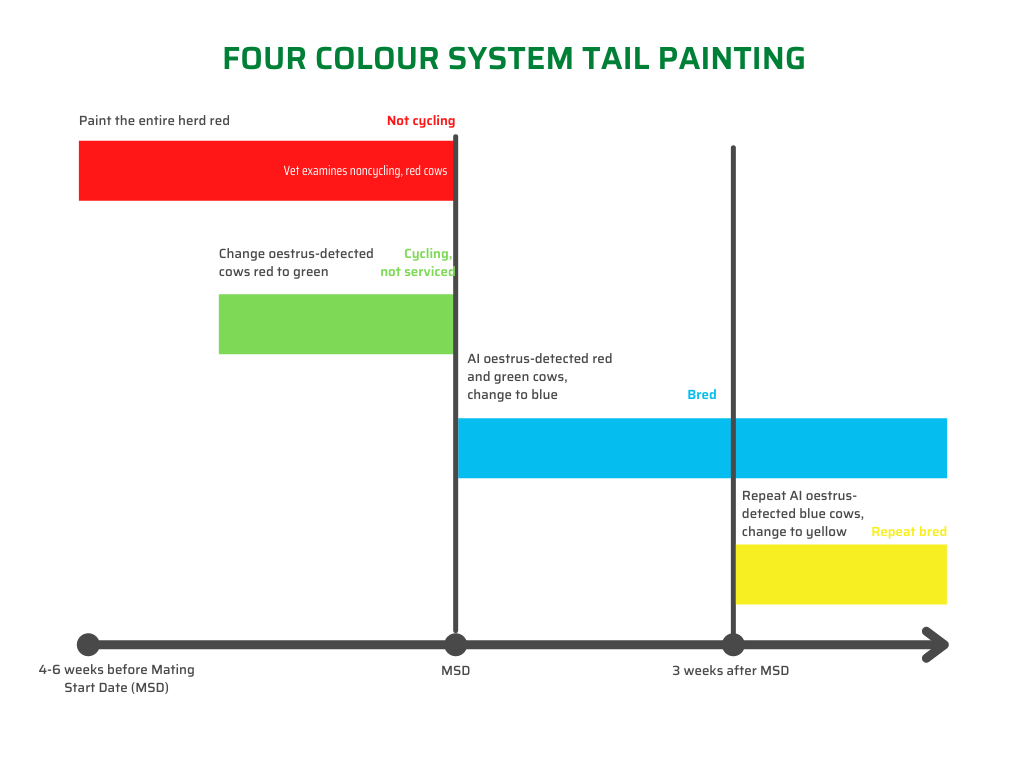With 20 years of knowledge from formulating architectural coatings specifically for the Irish market, combined with a keen farming background and PharVet’s knowledge in the area, Fleetwood Research & Development department has created RainBó Roller Tail Paint.
An exterior grade binder was chosen to make it impenetrable in wet conditions, special fluorescent pigments were sourced to ensure clear visibility over dark coloured cows and under poor lighting conditions.
The paint is designed to withstand environmental challenges of Irish weather extremes so that it will stay intact on the animal during adverse weather conditions.
By buying Rainbó Roller Tail Paint you are supporting Irish jobs and helping to cut down on emissions that come with importing tail paints from abroad.
Easy and rapid application
The paint has been designed with easy, rapid application in mind, greatly reducing application times compared to some existing brush applicators.
This unique product features include:
- Made in Ireland;
- Fluorescent colours for high visibility;
- Trialled and tested for all Irish weather conditions;
- Non-hazardous paint;
- Bittering agent included making it unpalatable for cows;
- Unique foam roller applicator;
- Paint crumbles upon contact;
- 750ml bottles available in red, blue, yellow, green, and pink. Also 2.5L size available.
Win 12 bottles of Rainbó Roller Tail Paint
The team at PharVet (Ireland) Ltd., distributors of Rainbó Roller Tail Paint (which is available through the trade channel), is launching a competition this year to give one farmer the chance to win 12 bottles of Rainbó Roller Tail Paint.
To be in with a chance of winning, click here to submit your details. Terms and conditions apply.

Hazell Mullins, large-animal vet and farmer, used Rainbó Roller last year during the breeding season.
According to Hazell it’s “really easy” to apply the tail paint with the roller.
“It only takes 2-3 rolls to get good coverage and can be seen easily,” she said.
“I love the colours and use a different colour for each stage of breeding. The paint crumbles very easily when the cow is mounted so its very easy to see when the cow is bulling in the parlour.
“It’s safe to use for animals and humans and it’s a great Irish product to support,” she added.
Four-colour system
Heat detection is key for achieving your herd’s targets this breeding season.
Make sure you start tail painting your cows 4-6 weeks prior to your mating start date. This will help identify cows that may not be cycling.
Most cows will display signs of heat between the hours of 9:00p.m and 7:00a.m so relying on observation alone to identify cows in heat could easily result in cows being missed.
Tail paint is an easy and effective aid that can help you achieve a high heat detection rate. Once a cow in heat has been mounted, the paint will be rubbed off, making her easy to identify.

The four-colour system of tail painting is a useful tool to identify non-cycling cows and repeats. The entire herd is painted red 4-6 weeks before the mating start date. Once oestrus is detected in a cow, she is painted green.
Those that are non-cycling can then be checked by the vet. Cows that are have been artificially inseminated are then painted blue. Anything that repeats is then changed to yellow.
Tail paint should be checked with each milking and topped-up as needed (fading) to give a positive identification of oestrus to plan for artificial insemination (AI).
Rainbó Roller Tail Paint is an addition to PharVet’s / Interchem’s range of fertility products to help identify and get cows back in calf.
Improve labour and submission rates
Synchronisation with fixed-time AI (FTAI) is an excellent tool to improve labour and submission rates and profitability on a farm.
The use of tail paint following synchronisation with FTAI helps identify animals that may need additional handling.
Ask your vet about how synchronisation can help on your farm. Always ask for the triangle device with the highest level of progesterone.
For more information, of if you have any questions, contact a member of the PharVet team below:


